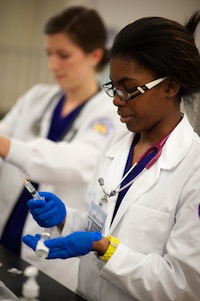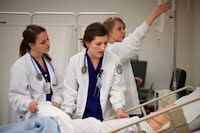Nursing Simulation a Matter of Life and Death
News
It's been nearly a month since 45-year-old Mark Langston was admitted to the hospital with appendicitis. A smoker with high blood pressure, he developed complications from surgery, including abdominal abscesses from his leaking appendix, a broken left ankle from when he tripped over the cord to his pain-control pump and acute respiratory failure from his compromised lungs. But after two and a half weeks in the intensive-care unit, Mark has finally begun showing some improvement and can once again breathe on his own. He was recently transferred from ICU to a resident unit.
"Hi, honey! I'm so glad you're here. I get to be with you now," his wife says upon entering the room. "Did you get rid of any other tubes? Oh, I am so glad, you're doing so much better. … I took the kids to school and I think you have a sister that wants to talk to you," she says, putting the phone up to his ear. But Mark, who just minutes ago could be heard coughing and complaining of hunger, is suddenly unresponsive. "Mark … Mark! Something's wrong!" she yells to the nurses nearby. "Hey, I don't think he's breathing! He doesn't have a pulse!"
One nurse begins chest compressions while another hits the code button to alert the attending physician. Moments later, Dr. Mallory arrives, but it is too late. "I'm going to call it," he says. "He's dead." A stunned silence falls over the room.
It's a scenario that plays out in hospitals every day across the country — only this particular drama unfolded in the classroom as part of the James Madison University nursing department's Advanced Skills Lab, and the patient is a high-fidelity simulator controlled by the instructor.
"It's not your fault," JMU professor of nursing Dr. Donna Trimm informs a relieved team of students, explaining that Mark developed a pulmonary embolism — a blood clot that enters the lungs — which is a common cause of death in patients who have had surgery and been on bed rest for a long period of time. "There's nothing you could have done."
The session ends with a few instructions from Trimm, then the class as a whole gathers for one final debriefing session. The discussion covers everything from what to do when a patient "codes," to how best to handle the hysterical wife, to breaking the news to the family. It's a fitting capstone to the semester-long saga — and a valuable lesson for undergraduate nurses in training.
"I feel like it bridges the gap between classroom and clinicals, and it's also a really safe way to try out as many different what-if situations as possible," said junior Kristen Bromaghim of Fredericksburg. "In the classroom, each skill we learn is so isolated from another skill. The simulation helps us put the big picture together."
"We have a limited amount of clinical time in the hospital, so (the simulation) throws us some different circumstances that we don't always get to see," added Kristen Breem, a junior from Winchester. "Personally, I never had a patient who stopped breathing during my clinical, so when we get that in a simulation, it makes you think, ‘what would I do?'"

"Since we're students, we always assume we're going to make some huge, detrimental mistake, and I think that when (Mark) coded, and we found out we hadn't done anything wrong, we had to shift our thinking," Bromaghim said.
The JMU nursing department's use of high-fidelity patient simulators allows students to develop and improve their bedside skills under realistic hospital conditions, all with the benefit of a safety net. "It's a controlled environment without the consequences of mistakes, which in the real world can be costly in many ways," said Dr. Julie Sanford, professor and head of nursing.
Last fall, the department welcomed HARVEY, who is capable of exhibiting 30 different heart conditions, and nursing's expanded lab in Burruss Hall next semester will simulate a woman giving birth. "Some clinical opportunities can be difficult to come by," Sanford said. "You can schedule a student to be in the delivery room, but you can't force the issue."
Anna Temple, a junior nursing student at JMU and an emergency medical technician from Boston, Mass., was grateful for the Mark Langston experience. "It was a reality check. It tells you what you do know and what you might still need to work on."
# # #
By James Heffernan ('96), JMU Public Affairs

